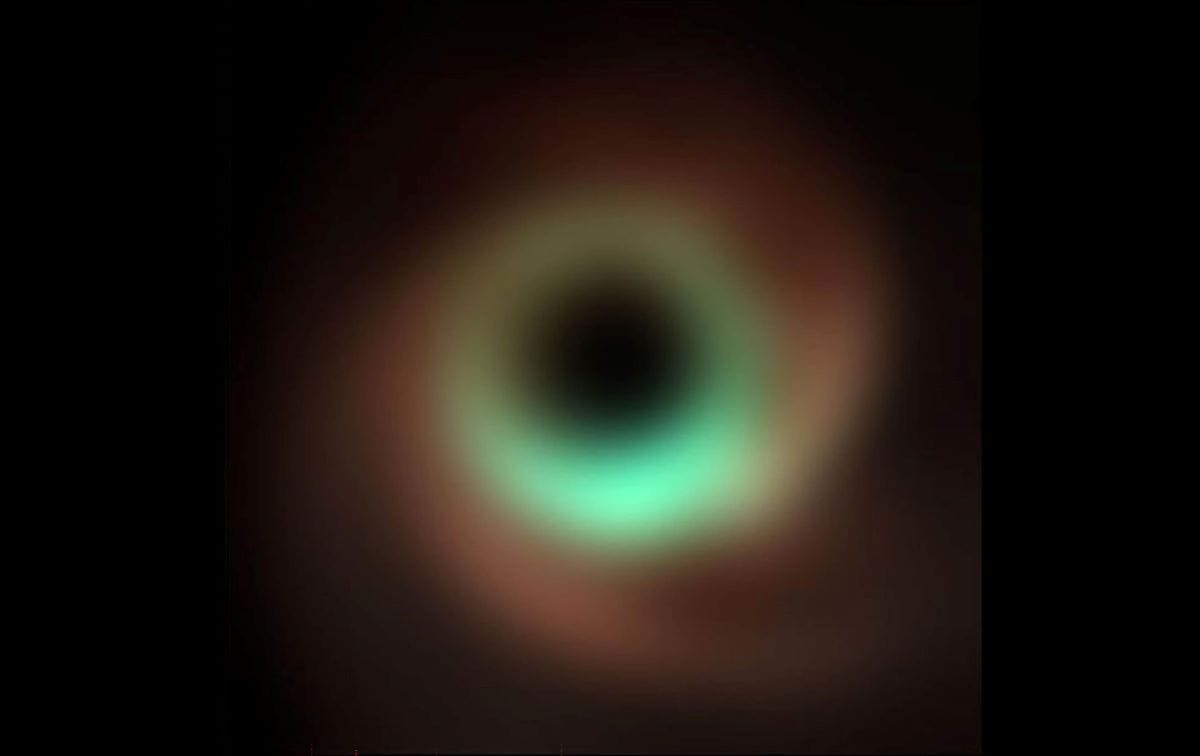The EHT's Cosmic Time Machine Captures Black Holes in Stunning Detail
The Event Horizon Telescope has achieved a groundbreaking milestone by capturing the highest resolution images ever obtained from Earth. This breakthrough paves the way for a deeper understanding of black holes and their surrounding environments.

The Event Horizon Telescope (EHT) collaboration, working in conjunction with the millimeter and submillimeter observatory ALMA, made test observations that allowed the highest resolution ever obtained from the Earth's surface to be achieved.
This was achieved by detecting light from the centers of distant galaxies at a frequency around 345 GHz, equivalent to a wavelength of 0.87 mm. The new detections were published in The Astronomical Journal.
"This result represents an important technical and scientific achievement, as it sets a new record of angular resolution for astronomy," said Laurent Loinard, a researcher at the Institute of Radio Astronomy and Astrophysics (IRyA) of the UNAM, Morelia campus, and member of the EHT collaboration.
Loinard added, "In the near future, this will allow us to image the black holes at the center of our Galaxy and M87 with a level of sharpness 50 percent better than what the Event Horizon Telescope has achieved so far."
The EHT creates an Earth-sized virtual telescope by linking multiple radio antennas around the world, using a technique called Very-long-baseline interferometry (VLBI). To obtain higher resolution images, the astronomical community has two options: increase the distance between the radio antennas or observe at a shorter wavelength.
Since the EHT was already the size of our planet, increasing the resolution of ground-based observations required extending its wavelength range, and that's what the collaboration has done now.
"With the EHT we saw the first images of black holes by detecting radio waves at the 1.3 mm wavelength, but the bright ring we saw, formed by light bending in the black hole's gravity, was still blurry because we were at the absolute limits of how sharp we could make the images," explained the co-director of the scientific article, Alexander Raymond, a researcher at NASA's Jet Propulsion Laboratory (United States).
"At 0.87mm, our images will be sharper and more detailed, which in turn will likely reveal new properties, both those that had been previously predicted and perhaps some that had not been predicted. "
This is the first time that the VLBI technique has been successfully used at a wavelength of 0.87 mm. The new experiment used some of the EHT's antennas in conjunction with ALMA to make measurements with a resolution of up to 19 microarcseconds. With the EHT complete, the collaboration could see details of up to 13 microarcseconds, as if observing the cap of a bottle on the Moon from Earth.
Co-director of the work, Sheperd "Shep" Doeleman, an astrophysicist at the Center for Astrophysics at Harvard and the Smithsonian, and founding director of the EHT, said of the breakthrough:
"Think of the explosion of extra detail you get when you go from black and white to color photos. This new 'color vision' allows us to separate the effects of Einstein's gravity from the magnetic fields and hot gas that power black holes and launch powerful jets that flow across galactic distances." "
With this in mind, he emphasized that the collaboration is excited to re-image M87* and Sgr A* at both 1.3mm and 0.87mm, and move from detecting black hole "shadows" to more accurately measuring their sizes and shapes, which can help estimate a black hole's spin and orientation in the sky.
This achievement also provides another step on the road to creating high-fidelity images of the black holes' event horizon environment, which will depend on upgrades to the existing antenna array.
The next-generation EHT (ngEHT) project will add new antennas to the EHT in optimized geographic locations and enhance existing stations by upgrading them so that they all operate at multiple wavelengths between 3mm and 0.87mm at the same time.
As a result of these and other updates, the global array is expected to increase by 10 times the amount of crisp and clear data the EHT uses to obtain images, allowing scientists to not only produce more detailed and sensitive images, but also videos of these violent cosmic beasts.
Mexico and the EHT
The Large Millimeter Telescope Alfonso Serrano, located on the Sierra Negra volcano in Puebla, is one of the radio wave observatories that participates in the Event Horizon Telescope (EHT). It is maintained by the National Institute of Astrophysics, Optics and Electronics (INAOE) and the University of Massachusetts, United States.
The Mexican community that participates in the EHT collaboration includes at least 10 people in foreign or national institutions, such as the IRyA and the Institute of Astronomy, both of the UNAM, and the INAOE.
The EHT collaboration involves more than 300 people from Africa, Asia, Europe, and North and South America to capture the most detailed images of black holes ever obtained by creating a virtual telescope the size of Earth. Supported by considerable international investment, the EHT links existing telescopes using novel systems, creating a fundamentally new instrument with the highest angular resolving power ever achieved.
The individual telescopes involved are: ALMA, APEX, IRAM 30-metre telescope, IRAM NOEMA Observatory, James Clerk Maxwell Telescope (JCMT), Large Millimeter Telescope (GTM/LMT), Submillimeter Array (SMA), Submillimeter Telescope (SMT), South Pole Telescope (SPT), Kitt Peak Telescope, and Greenland Telescope (GLT).
The data were correlated at the Max Planck Institute for Radio Astronomy (MPIfR) and the Haystack Observatory at the Massachusetts Institute of Technology (MIT). The post-processing was carried out within the collaboration of an international team in different institutions.
The EHT consortium consists of 13 interested institutes: Institute of Astronomy and Astrophysics of the Academia Sinica, University of Arizona, University of Chicago, East Asia Observatory, University Frankfurt-Goethe, Institute for Millimeter Radio Astronomy.
Also, the Large Millimeter Telescope, Max Planck Institute for Radio Astronomy, Haystack Observatory of the Massachusetts Institute of Technology, National Astronomical Observatory of Japan, Perimeter Institute for Theoretical Physics, Radboud University, and the Smithsonian Astrophysical Observatory.
The EHT collaboration website is: eventhorizontelescope.org
Scientific article
First Very Long Baseline Interferometry Detections at 870 μm
A. W. Raymond et al. (2024)
The Astronomical Journal, 168, 130
https://doi.org/10.3847/1538-3881/ad5bdb




